Philippine Navy
The Philippine Navy (PN; Filipino: Hukbong Dagat ng Pilipinas; Spanish: Fuerza Naval de Filipinas) is the naval warfare service branch of the Armed Forces of the Philippines. It has an estimated strength of 25,000 active service personnel, including the 9,500-strong Philippine Marine Corps.[2] It operates 115 ships and 25 aircraft. It shares the responsibility of patrolling the maritime borders with the Philippine Coast Guard, a formerly attached unit which became a separate maritime law enforcement agency in 1998.
| Philippine Navy | |
|---|---|
| Hukbong Dagat ng Pilipinas | |
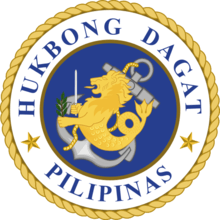 Seal of the Philippine Navy | |
| Founded | May 20, 1898[1] |
| Country | |
| Type | Navy |
| Size | 25,000 active personnel (including 9,500 Philippine Marine Corps)[2] 15,000 Reserve Personnel 115 ships 25 aircraft |
| Part of | Armed Forces of the Philippines |
| Headquarters | Naval Station Jose Andrada, Roxas Boulevard, Manila |
| Equipment | List of Philippine Navy equipment |
| Engagements | Philippine Revolution Spanish–American War Philippine–American War World War II Communist Insurgencies Moro conflict Spratly Islands Dispute Scarborough Shoal standoff Battle of Marawi |
| Website | www |
| Commanders | |
| Commander-in-Chief | President Rodrigo Roa Duterte |
| Secretary of National Defense | Delfin Lorenzana |
| Chief of Staff | Gen. Felimon Santos Jr., AFP |
| Flag Officer in-Command | VADM Giovanni Bacordo, AFP |
| Vice Commander | RADM Rey T. Dela Cruz, AFP |
| Chief of Naval Staff | RADM Adeluis S. Bordado, AFP |
| Insignia | |
| Pennant | |
| Jack |  |
| Flag |  |
| Patch |  |
History
Pre-colonial period
Before the Spanish arrived in the Philippines the ancient peoples there were engaging in naval warfare, trade, piracy, travel and communication using balangay.[3] A flotilla of balangay was discovered in the late 1970s in Butuan City, Agusan del Norte.[4]
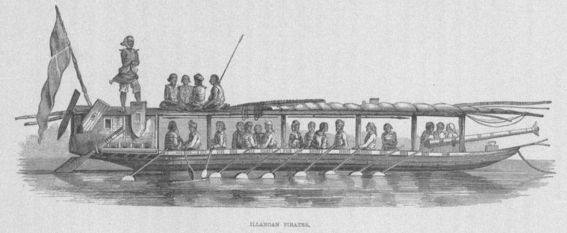
Philippine ships, such as the karakao or korkoa, were of excellent quality and some of them were used by the Spaniards in expeditions against rebellious tribes and Dutch and British forces. Some of the larger rowed vessels held up to a hundred rowers on each side besides a contingent of armed troops. Generally, the larger vessels held at least one lantaka at the front of the vessel or another one placed at the stern. Philippine sailing ships called praos had double sails that seemed to rise well over a hundred feet from the surface of the water. Despite their large size, these ships had double outriggers. Some of the larger sailing ships, however, did not have outriggers.[5]
Antecedent to this raids, sometime between A.D. 1174 and 1190, a traveling Chinese government bureaucrat Chau Ju-Kua reported that a certain group of "ferocious raiders of China’s Fukien coast" which he called the "Pi-sho-ye," believed to have lived on the southern part of Formosa.[6] In A.D. 1273, another work written by Ma Tuan Lin, which came to the knowledge of non-Chinese readers through a translation made by the Marquis D’Hervey de Saint-Denys, gave reference to the Pi-sho-ye raiders, thought to have originated from the southern portion of Formosa. However, the author observed that these readers spoke a different language and had an entirely different appearance (presumably when compared to the inhabitants of Formosa).[6]
In the Battle of Manila in 1365 is an unspecified and disputed battle occurring somewhere in the vicinity of Manila between the forces of the Kingdoms in Luzon and the Empire of Majapahit.
Even though the exact dates and details of this battle remain in dispute, there are claims of the conquest of the area around Saludong (Majapahit term for Luzon and Manila) according to the text Nagarakretagama[7]
Nevertheless, there may have been a battle for Manila that occurred during that time but it was likely a victory for Luzon's kingdoms considering that the Kingdom of Tondo had maintained its independence and was not enslaved under another ruler. Alternatively, Luzon may have been successfully invaded but was able to regain its independence later.[8][9]
Colonial era
The Spanish Colonial Era
The Republic's need for a naval force was first provided for by Filipino revolutionaries when they included a provision in the Biák-na-Bató Constitution. This authorised the government to permit privateers to engage foreign enemy vessels.[10]
(w)hen the necessary army is organized … for the protection of the coasts of the Philippine archipelago and its seas; then a secretary of the navy shall be appointed and the duties of his office added to this Constitution.
On May 1, 1898, the first ship handed by Admiral George Dewey to the Revolutionary Navy is a small pinnace from the Reina Cristina of Admiral Patricio Montojo, which was named Magdalo.[10]
The Philippine Navy was established during the second phase of the Philippine Revolution when General Emilio Aguinaldo formed the Revolutionary Navy which was initially composed of a small fleet of eight Spanish steam launches captured from the Spaniards. The ships were refitted with 9-centimeter guns. The rich, namely Leon Apacible, Manuel Lopez and Gliceria Marella de Villavicencio, later donated five other vessels of greater tonnage, the Taaleño, the Balayan, the Bulusan, the Taal and the Purísima Concepción. The 900-ton inter-island tobacco steamer further reinforced the fleet, Compania de Filipinas (renamed as the navy flagship Filipinas), steam launches purchased from China and other watercraft donated by wealthy patriots.[10][11]
Naval stations were later established to serve as ships' home bases in the following:[11]
- Ports of Aparri
- Ports of Legaspi
- Ports of Balayan
- Ports of Calapan
- Ports of San Roque, Cavite
On September 26, 1898, Aguinaldo appointed Captain Pascual Ledesma (a merchant ship captain) as Director of the Bureau of the Navy, assisted by Captain Angel Pabie (another merchant ship captain). After passing of the Malolos Constitution the Navy was transferred from the Ministry of Foreign Relations to the Department of War (thereafter known as the Department of War and the Navy) headed by Gen. Mariano Trías.[10][11]
As the tensions between Filipinos and Americans erupted in 1899 and a continued blockade on naval forces by the Americans, the Philippine naval forces started to be decimated.[10]
American Colonial Period

The American colonial government in the Philippines created the Bureau of the Coast Guard and Transportation, which aimed to maintain peace and order, transport Philippine Constabulary troops throughout the archipelago, and guard against smuggling and piracy. The Americans employed many Filipino sailors in this bureau and in the Bureaus of Customs and Immigration, Island and Inter-Island Transportation, Coast and Geodetic Survey, and Lighthouses. They also reopened the former Spanish colonial Escuela Nautica de Manila, which was renamed the Philippine Nautical School, adopting the methods of the United States Naval Academy at Annapolis. The U.S. Naval Academy accepted its first Filipino midshipman in 1919, and Filipinos were able to enlist in the U.S. Navy, just as they were formerly able to do in the Spanish Navy.[10]
World War II and Japanese occupation (1941–1945)
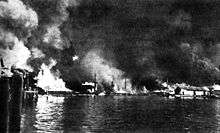

In 1935, the Commonwealth Government passed the National Defense Act, which aimed to ensure the security of the country. This was criticized because it placed the burden of the defense of the Philippines on ground forces, which in turn, was formed from reservists. It discounted the need for a Commonwealth air force and navy, and naval protection was provided by the United States Asiatic Fleet.[10]
"A relatively small fleet of such vessels, ...will have distinct effect in compelling any hostile force to approach cautiously and by small detachments."
— Gen. Douglas MacArthur, Military Advisor to the Philippines regarding the newest Offshore Patrol (OSP) PT boats[12]
When World War II began, the Philippines had no significant naval forces after the United States withdrew the Asiatic Fleet following the attack on Pearl Harbor by the Imperial Japanese Navy. The Philippines had to rely on its OSP with headquarters located at Muelle Del Codo, Port Area, Manila, composed of five high-speed Thorneycroft Coast Motor Boat (CMB) 55-foot (17 m) and 65-foot (20 m) PT boats, also known as Q-boats, to repel Japanese attacks from the sea.[10][11]
During the course of the war, the OSP were undaunted by the enemy's superiority which they fought with zeal, courage and heroism. For its intrepid and successful missions and raids on enemy ships, the unit was dubbed the "Mosquito Fleet" mainly because of its minuscule size, speed and surprise, it showed its capability to attack with a deadly sting. The unit was cited for gallantry in action when its Q-boats Squadron shot three of nine Japanese dive bombers as they were flying towards shore installations in Bataan.[13] The OSP participated in the evacuation of high Philippine and U.S. government officials from Manila to Corregidor when Manila was declared an open city.[14] Surviving personnel of the Offshore Patrol that didn't surrender after April 9, 1942 to the Japanese, conducted the recognized guerrilla and local military troops of the Philippine Commonwealth Army were hit-and-run attacks against the occupying Japanese forces until the return of U.S. Forces.[10] By the end of the war, 66 percent of its men were awarded the Silver Star Medal and other decorations for gallantry in action.
Post-war period (1945–1992)
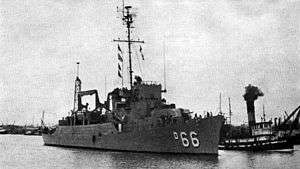
In 1945, after the liberation of the Philippines, the OSP was reactivated and led by Major Jose Andrada, to reorganize and rebuild from a core of surviving OSP veterans, plus additional recruits. The OSP was strengthened in 1947 after President of the Philippines Manuel Roxas issued Executive Order No. 94. This order elevated the Patrol to a major command that was equal with the Philippine Army, Constabulary, and Air Force. The OSP was renamed the Philippine Naval Patrol, later on changed its name again to the Philippine Navy on January 5, 1951. The first commanding officer of the Navy, Jose Andrada, became its first Commodore and Chief.[10][11] This was also the year when the naval aviation arm of the Navy was formed, now the Naval Air Group.
In 1950, Secretary of Defense Ramon Magsaysay created a marine battalion with which to carry out amphibious attacks against the Communist Hukbalahap movement. The next year, President Elpidio Quirino issued Executive Order No. 389, re-designating the Philippine Naval Patrol as the Philippine Navy. It was to be composed of all naval and marine forces, combat vessels, auxiliary craft, naval aircraft, shore installations, and supporting units that were necessary to carry out all functions of the service.[10]
The Philippine Navy participated in the Korean War, as well as the Vietnam War, supporting in civil and medical operations. By the 1960s, the Philippine Navy was one of the best-equipped navies in Southeast Asia. In 1967, the maritime law enforcement functions of the Navy were transferred to the Philippine Coast Guard. The duties stayed with the coast guard and in the 1990s it became an independent service under the Department of Transportation.[10]
After the 1960s, the government had to shift its attention towards the Communist insurgency and this led to the strengthening of the Philippine Army and the Philippine Air Force while naval operations were confined to troop transport, naval gunfire support, and blockade.[10]
US military departure from the Philippines
The Cold War era had reached its endpoint as tensions between the two ideological rivals, the United States and the Soviet Union, simmered down as a result of the dissolution of the latter and the massive change of political system among its allies.

.jpg)
.jpg)
The fate of the US military bases in the country was greatly affected by these circumstances, aside from the catastrophic eruption of Mount Pinatubo in 1991 which engulfed the installations with ash and lava flows. The nearby Clark Air Base was eventually abandoned afterwards, while the Philippine Senate voted to reject a new treaty for Subic Naval Complex, its sister American installation in Zambales. This occurrence had effectively ended the century-old US military presence in the country, even as President Corazon Aquino tried to extend the lease agreement by calling a national referendum, leaving a security vacuum in the region and terminated the inflows of economic and military aid into the Philippines. [15] [16]
Contemporary period (1992–present)
Concerns about the Chinese incursion to the sea features claimed by the Philippines and other Southeast Asian states were arises after the Chinese construction of a military outpost at the Mischief Reef on 1995. As a response, the Philippine Navy dispatched the BRP Sierra Madre and deliberately ran it aground in the Second Thomas Shoal, 5 miles from the Chinese facility and south of the rumored oil-rich Reed Bank, which it maintains as its own station today.[17][18]
The importance of territorial defense capability was highlighted in the public eye in 1995 when the AFP published photographs of Chinese structures on Mischief Reef in the Spratlys. Initial attempts to improve the capabilities of the armed forces happened when a law was passed in the same year for the sale of redundant military installations and devote 35% of the proceeds for the AFP upgrades. Subsequently, the legislature passed the AFP Modernization Act. The law sought to modernize the AFP over a 15-year period, with minimum appropriation of 10-billion pesos per year for the first five years, subject to increase in subsequent years of the program. The modernization fund was to be separate and distinct from the rest of the AFP budget. The Asian Financial Crisis which struck the region on 1997, greatly affected the AFP Modernization Program due to the government's austerity measures meant to turn the economy around after suffering from losses incurred during the financial crisis.[19]
In 1998, following the closure of US bases, the Philippines-US Visiting Forces Agreement (VFA) was signed which contained guidelines for the conduct and protection of American troops visiting the Philippines and stipulated the terms and conditions for the American military to enter Philippine territory. The VFA is a reciprocal agreement that also outlines the requirements for Philippine troops visiting the United States. The Visiting Forces Agreement led to the establishment of the Balikatan exercises, an annual US-Philippine military exercise, as well as a variety of other cooperative measures including the Philippine Bilateral Exercises (PHIBLEX) between the naval forces of the two countries.[20][21]
The next decade ushered in a cordial relationship between China and its maritime neighbours including the Philippines until 2011 when tensions rose again after consecutive incidents occurred in the disputed territories. In 2012, a Philippine surveillance aircraft identified Chinese fishing vessels at the then Philippine-controlled Scarborough Shoal, causing the Philippine Navy to deploy the BRP Gregorio del Pilar to the area. In response, China sent surveillance ships to warn the Navy to leave the area claimed by both countries, prompting a standoff. The two nations eventually agreed to withdraw their deployed vessels as the arrival of the typhoon season drew near.[22][23] Following a 3-month standoff between Philippine and Chinese vessels around Scarborough Shoal, China informed the Philippines that Chinese coast guard vessels will remain permanently on the shoal as an integral part of their 'Sansha City' in the Woody island of the Paracels, a separate archipelago disputed by China and Vietnam. Under the control of Hainan Province. the Chinese government plans the island-city to have administrative control over a region that encompasses not only the Paracels, but Macclesfield Bank, a largely sunken atoll to the east, and the Spratly Islands to the south.[24]
The incidents with the Chinese presence in the South China Sea prompted the Philippines to proceed with formal measures while challenging the Chinese activities in some of the sea features in the disputed island chain. Hence, the South China Sea Arbitration Case was filed by the Philippines in 2013 at the International Tribunal for the Law of the Sea (ITLOS).[25] Reminiscent to what occurred on 1995, the Congress passed the Revised AFP Modernization Act of 2012, this was meant to replace the older AFP Modernization Act of 1995, when the 15-year program expired in 2010. Major naval assets for acquisition under the new AFP modernization program include: 2 frigates, 2 corvettes, 2 strategic sealift vessels (SSV), 6 offshore patrol vessels, missile and other weapon systems upgrade, among others.[26] However, the Navy remains unable to protect other Philippine Reefs that have been reclaimed by the Chinese.[27]
Organization
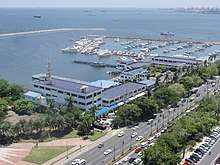



The Philippine Navy is administered through the Department of National Defense (DND). Under the AFP structure, the Chief of Staff, AFP (CSAFP), a four-star general/admiral (if the officer is a member of the Philippine Navy), is the most senior military officer. The senior naval officer is the Flag Officer-in-Command (FOIC), usually with a rank of vice admiral. He, along with his or her air force and army counterparts, is junior only to the CSAFP. The FOIC is solely responsible for the administration and operational status of the Navy. The FOIC's counterpart in the U.S. Navy is the Chief of Naval Operations.[11]
Currently, the navy establishment is actually composed of two type commands, the Philippine Fleet and Philippine Marine Corps (PMC). It is further organized into seven naval operational commands, five naval support commands, and seven naval support units. Considering the vastness of the territorial waters that the Navy has to protect and defend, optimal deployment of naval resources is achieved through identification of suitable locations where the presence of these units are capable of delivering responsive services.[11]
The Philippine Fleet, or simply the "Fleet", is under the direct command of the Commander Philippine Fleet while the marine corps is answerable to the commandant, PMC (CPMC). The Flag Officer-In-Command (FOIC) has administrative and operational control over both commands.[11]
Naval Operational Commands
The seven Naval Operation Commands are as follows:
- Naval Forces Northern Luzon (NAVFORNOL)
- Naval Forces Southern Luzon (NAVFORSOL)
- Naval Forces West (NAVFORWEST)
- Naval Forces Central (NAVFORCEN)
- Naval Forces Western Mindanao (NAVFORWESM)
- Naval Forces Eastern Mindanao (NAVFOREASTM)
- Fleet Marine Ready Force
NAVFORWEM and NAVFOREM were formed in August 2006 when Southern Command was split to allow more effective operations against Islamist and Communist rebels within the region.[29]
Naval Support Commands
The five Naval Support Commands are as follows:
- Naval Sea Systems Command (NSSC)
- Naval Education and Training Command (NETC)
- Naval Reserve Command (NAVRESCOM)
- Naval Combat Engineering Brigade (NCEBde)
- Naval Installation Command (NIC)
Naval Sea Systems Command
The Naval Sea Systems Command (NSSC), formerly known as Naval Support Command (NASCOM), provides quality and integrated naval system support and services in order to sustain the conduct of naval operations. It is the biggest industrial complex of the Armed Forces of the Philippines. It operates the country's military shipyards, develops new technologies for the Navy, and conducts maintenance on all the Navy's ships. NSSC's principal facilities are at the offshore operating base at Muelle de Codo and at Fort San Felipe in Cavite City.[29]
Naval Education, Training and Doctrine Command
The Naval Education, Training & Doctrine Command (NETDC) is the Philippine Navy's institution of learning. Its mission is to provide education and training to naval personnel so that they may be able to pursue progressive naval careers. NETDC is located in Naval Station Leovigildo Gantioqui, San Antonio, Zambales.[29][30]
Naval Reserve Command
The Naval Reserve Command (NAVRESCOM) organizes, trains, and administers all naval reservists (which includes the Naval Reserve Officers Training Corps Units midshipmen and midshipwomen). It is responsible for recalling reservists to provide the PN the base for expansion to meet sudden spikes in military manpower demand, as for war, rebellion or natural disaster/calamities and to assist in the socio-economic development of the country. The NAVRESCOM is presently based at Fort Santiago, Manila. It was formerly known as the Home Defense Command.[29]
Naval Combat Engineering Brigade
The Naval Combat Engineering Brigade (NCEBde), more popularly known as the Seabees, is tasked with combat engineering and amphibious construction in support of Fleet-Marine operations. Naval combat engineers perform tasks such as mobility, counter-mobility, assault, survivability and construction in the conduct of ground combat and amphibious operations. It executes under combat conditions the construction of roads, bridges and other vital infrastructures; the rehabilitation of piers, harbors and beach facilities; and harbor clearing and salvage works. Along with the Philippine Marine Corps, the NCEBde is charged with the manning and security of naval garrisons in shoals and islands located in the West Philippine Sea. The motto of the Seabees is "We build, We fight!"[31]
Naval Installation Command
The Naval Installation Command (NIC), formerly Naval Base Cavite, provides support services to the Philippine Navy and other AFP tenant units in the base complex, such as refueling, re-watering, shore power connections, berthing, ferry services, tugboat assistance, sludge disposal services and housing.[29]
Naval support units

.jpg)
The 9 Naval Support Units are as follows:
- Bonifacio Naval Station
- Civil Military Operations Group-Philippine Navy
- Naval Information and Communication Technology Center
- Fleet-Marine Warfare Center
- Headquarters Philippine Navy & Headquarters Support Group
- Naval Intelligence and Security Force
- Philippine Navy Finance Center
- Naval Logistics Center
- Navy Personnel Management Center
Equipment
Ships

The names of commissioned ships of the Philippine Navy are prefixed with the letters "BRP", designating "Barko ng Republika ng Pilipinas" (Ship of the Republic of the Philippines). The names of ships are often selected to honor important people and places. The Philippine Navy is currently operating 115 ships as follows:
- Submarine: 0 (+2 planned)
- Frigates: 1 (+1 for delivery)
- Corvettes: 1 (+2 planned)
- Offshore patrol vessels: 10 (+6 planned)
- Littoral patrol craft: 6
- Coastal patrol craft: 24
- Fast attack interdiction craft: 34 (+8 on order)
- Landing platform dock: 2 (+2 planned)
- Landing ship tank / Logistics support vessel: 5
- Landing craft, utility: 19
- Auxiliary ships: 13
Aircraft

The Naval Air Group has 25 naval air assets. It prepares and provides these forces for naval operations with assets mainly for maritime reconnaissance and support missions. Its headquarters is located at Danilo Atienza Air Base, Cavite City. It has four units which operates several variant of aircraft: 32nd Maritime Patrol and Reconnaissance Squadron (Beechcraft King Air C-90), Naval Aviation Squadron MF-30 (BN-2A Islander), Naval Aviation Squadron MH-40 (AgustaWestland AW159 Wildcat, AgustaWestland AW109E Power, and MBB Bo 105C) and Naval Air School Center NATS-50 (Cessna Skyhawk 172M and Robinson R22 Beta II).
Bases
| Naval Base | Location | Description |
|---|---|---|
| Luzon | ||
| Naval Base Heracleo Alano (Naval Base Cavite) | Cavite City, Cavite | Headquarters of the Philippine Fleet. |
| Naval Base Camilo Osias (Naval Base San Vicente) | Santa Ana, Cagayan | |
| Naval Station | Location | Description | ||
|---|---|---|---|---|
| NCR | ||||
| Naval Station Jose Andrada (Fort San Antonio Abad) | Manila | Headquarters of the Philippine Navy. | ||
| Naval Station Jose Francisco (Bonifacio Naval Station) | Taguig | Part of it was developed as Bonifacio Global City. | ||
| Luzon | ||||
| Naval Station Heracleo Alano (Sangley Point) | Cavite City, Cavite | Headquarters of Naval Air Group | ||
| Naval Station Pascual Ledesma (Fort San Felipe) | ||||
| Naval Station Ernesto Ogbinar (Naval Station Poro Point) | San Fernando, La Union | Headquarters of Naval Forces Northern Luzon | ||
| Naval Station Leovigildo Gantioqui (Naval Station San Miguel) | San Antonio, Zambales | Headquarters, Naval Education, Training and Doctrine Command | ||
| Naval Station Narciso Del Rosario (Naval Station Balabac) | Balabac Island, Palawan | |||
| Naval Station Emilio Liwanag (Naval Station Pag-asa) | Kalayaan Islands, Palawan | |||
| Naval Station Apolinario Jalandoon (Naval Station Puerto Princesa) | Puerto Princesa, Palawan | |||
| Naval Station Carlito Cunanan (Naval Station Ulugan) | Ulugan, Palawan | |||
| Naval Station Julhasan Arasain (Naval Station Legaspi) | Legazpi, Albay | Headquarters of Naval Forces Southern Luzon | ||
| Visayas | ||||
| Naval Station Alfonso Palencia (Naval Station Guimaras) | Guimaras | |||
| Naval Station Dioscoro Papa (Naval Station Tacloban) | Tacloban, Leyte | |||
| Mindanao | ||||
| Naval Station Felix Apolinario (Naval Station Davao) | Davao City | Headquarters of Naval Forces Eastern Mindanao | ||
| Naval Station Romulo Espaldon (Naval Station Zamboanga) | Zamboanga City | Headquarters of Naval Forces Western Mindanao | ||
| Naval Station Rio Hondo | ||||
| Naval Station Juan Magluyan (Naval Operating Base Batu-Batu) | Panglima Sugala, Tawi-Tawi | |||
| Marine Base | Location | Description |
|---|---|---|
| Luzon | ||
| Marine Barracks Rudiardo Brown (Marine Base Manila) | Taguig | Headquarters of the Philippine Marine Corps. |
| Marine Barracks Gregorio Lim (Marine Base Ternate) | Ternate, Cavite | Contains the Marine Basic School Campus. |
| Mindanao | ||
| Marine Barracks Arturo Asuncion (Marine Base Zamboanga) | Zamboanga City | |
| Marine Barracks Domingo Deluana (Marine Base Tawi-Tawi) | Tawi-Tawi | |
| Camp Gen. Teodulfo Bautista | Jolo, Sulu | |
Future ships
| Class | Photo | Type | Ships | Origin | Quantity | Notes |
|---|---|---|---|---|---|---|
| Corvette | Corvette | 2 | With ABC of 28 Billion pesos, DND decided that it would be a Gov't to Gov't transaction with the proponent going to South Korea for a soft loan agreement. Only awaiting for funds for the downpayment. | |||
| Offshore Patrol Vessel | Offshore Patrol Vessel | 6 | With ABC of 30 Billion pesos, DND decided that it would be a Gov't to Gov't transaction with the proponent going to Australia for a soft loan agreement. Only awaiting funds for the downpayment. | |||
| Fast attack craft | Fast attack craft | 8 | With ABC of 10 Billion pesos, DND decided that it would be a Gov't to Gov't transaction with the proponent going to Israel along with a transfer of technology agreement. They have chosen the Shaldag V with 4 boats to be built in Israel while the remaining 4 boats will be built in the Philippines. Only awaiting funds for the downpayment. | |||
| Landing Platform Dock | Landing Platform Dock | 2 | With ABC of 5 Billion pesos,The Philippine Navy released a requirement for two more LPDs which are believed to be improvements over the Tarlac-class. Tender currently ongoing, which PT-PAL Passed post Qualification for the project. | |||
Gallery
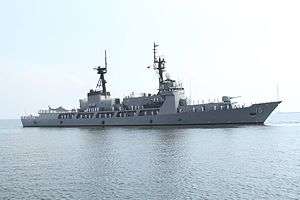 BRP Gregorio del Pilar (PS-15) is the current flagship of the Philippine Navy.
BRP Gregorio del Pilar (PS-15) is the current flagship of the Philippine Navy.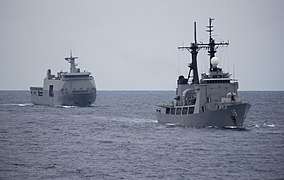 BRP Ramon Alcaraz (PS-16) and BRP Tarlac (LD-601) sail in formation during the at-sea portion of Maritime Training Activity (MTA) Sama Sama 2018.
BRP Ramon Alcaraz (PS-16) and BRP Tarlac (LD-601) sail in formation during the at-sea portion of Maritime Training Activity (MTA) Sama Sama 2018..jpg) BRP Conrado Yap (PS-39) is considered as the Navy's most heavily armed warship.
BRP Conrado Yap (PS-39) is considered as the Navy's most heavily armed warship. BRP Juan Magluyan (PC 392), a Jose Andrada-class patrol craft.
BRP Juan Magluyan (PC 392), a Jose Andrada-class patrol craft. A Multipurpose Assault Craft docked at Naval Station Jose Andrada (PN Headquarters) in Manila.
A Multipurpose Assault Craft docked at Naval Station Jose Andrada (PN Headquarters) in Manila.
See also
References
- Citations
- "PGMA's Speech during the 105th Founding Anniversary of the Philippine Navy". Archived from the original on October 8, 2007. Retrieved June 6, 2008.
- "Philippine National Security". tagaloglang.com. Archived from the original on June 6, 2012. Retrieved May 26, 2012.
- "What is the Balangay?". balangay-voyage.com. Kaya ng Pinoy Inc. Archived from the original on February 27, 2012. Retrieved July 21, 2012.
- Roperos, Robert E. (May 28, 2012). "Archeologists to resume excavation of remaining Balangay boats in Butuan". Philippine Information Agency (PIA). Archived from the original on December 21, 2012. Retrieved July 21, 2012.
- It was integrated to the Spanish Empire through pacts and treaties (c.1569) by Miguel López de Legazpi and his grandson Juan de Salcedo. During the time of their Hispanization, the principalities of the Confederation were already developed settlements with distinct social structure, culture, customs, and religion.
- "3 of 5 Agusta choppers delivered to PH Navy". newsinfo.inquirer.net. Archived from the original on May 2, 2014. Retrieved July 25, 2014.
- Malkiel-Jirmounsky, Myron (1939). "The Study of The Artistic Antiquities of Dutch India". Harvard Journal of Asiatic Studies. Harvard-Yenching Institute. 4 (1): 59–68. doi:10.2307/2717905. JSTOR 2717905.
- Tiongson, Jaime (November 29, 2006). "Pailah is Pila, Laguna". Archived from the original on July 7, 2012. Retrieved February 5, 2008.
- Santos, Hector (October 26, 1996). "The Laguna Copperplate Inscription". Archived from the original on November 21, 2014. Retrieved October 7, 2014.
- Zulueta, Joselito. "History of the Philippine Navy". Philippine Navy. Archived from the original on February 17, 2010. Retrieved July 21, 2012.
- "THE PHILIPPINE NAVY" (pdf). dlsu.edu.ph. De La Salle University-Manila (ROTC). Archived (PDF) from the original on September 14, 2012. Retrieved July 21, 2012.
- Morton, Louis. The War in the Pacific: Fall of the Philippines. p.11, 1953. Washington D.C.: U.S. Government Printing House, 1993.
- "Remembering the Battle for Bataan, 1942" Archived March 1, 2016, at the Wayback Machine, The Bataan Campaign Website, February 22, 2014, Retrieved February 13, 2016.
- Davis, David, LT, USMC, Page 14, "Introducing: The Philippine Navy" Archived September 16, 2015, at the Wayback Machine, All Hands: The Bureau of Naval Personnel Career Publication, Number 558, Issue: July 1963, Retrieved February 18, 2016.
- "PHILIPPINE SENATE VOTES TO REJECT U.S. BASE RENEWAL". The New York Times. Archived from the original on March 19, 2018. Retrieved March 19, 2018.
- "CLOSURE OF U.S. MILITARY BASES IN THE PHILIPPINES: IMPACT AND IMPLICATIONS" (PDF). dtic.mil. Archived (PDF) from the original on March 29, 2018. Retrieved March 19, 2018.
- Archived March 21, 2018, at the Wayback Machine, Retrieved March 21, 2018.
- Archived March 22, 2018, at the Wayback Machine, Retrieved March 21, 2018.
- Archived March 21, 2018, at the Wayback Machine, Retrieved March 21, 2018.
- , Retrieved March 21, 2018.
- Archived March 21, 2018, at the Wayback Machine, Retrieved March 21, 2018.
- Archived March 22, 2018, at the Wayback Machine, Retrieved March 21, 2018
- , Retrieved March 21, 2018
- Archived March 22, 2018, at the Wayback Machine, Retrieved March 21, 2018
- Archived March 21, 2018, at the Wayback Machine, Retrieved March 21, 2018
- Archived March 21, 2018, at the Wayback Machine, Retrieved March 21, 2018
- Mangosing, Frances G. "China military planes land on PH reef". Archived from the original on April 18, 2018. Retrieved April 17, 2018.
- "GlobalSecurity.org – Philippine Navy Organization". GlobalSecurity.org. Archived from the original on November 2, 2012. Retrieved March 24, 2010.
- "Naval Education and Training Command". netc-navy.edu.ph. Archived from the original on April 22, 2009. Retrieved March 24, 2010.
- "Naval Combat Engineering Brigade". Naval Combat Engineering Brigade. Archived from the original on December 22, 2014. Retrieved November 26, 2014.
- Bibliography
- Philippine Navy. (1998). Tides of change. Manila: Philippine Navy.
- Philippine Navy. (2007). The Philippine Navy Strategic Sail Plan 2020 Book 1 2007. Manila: Philippine Navy
- Philippine Navy. (2014). "Rough Deck Log: 2014 Philippine Navy Anniversary Issue: To The Shores of Pusan: Combat Service Support and Escort Operations of the Philippine Navy in the Korean War (1950–1953)" by CDR Mark R Condeno
.svg.png)